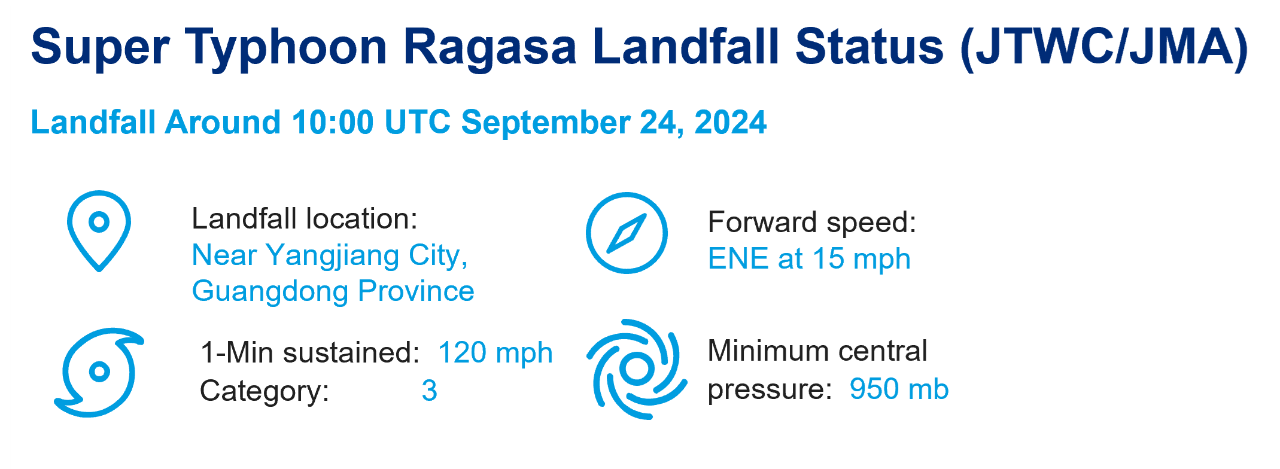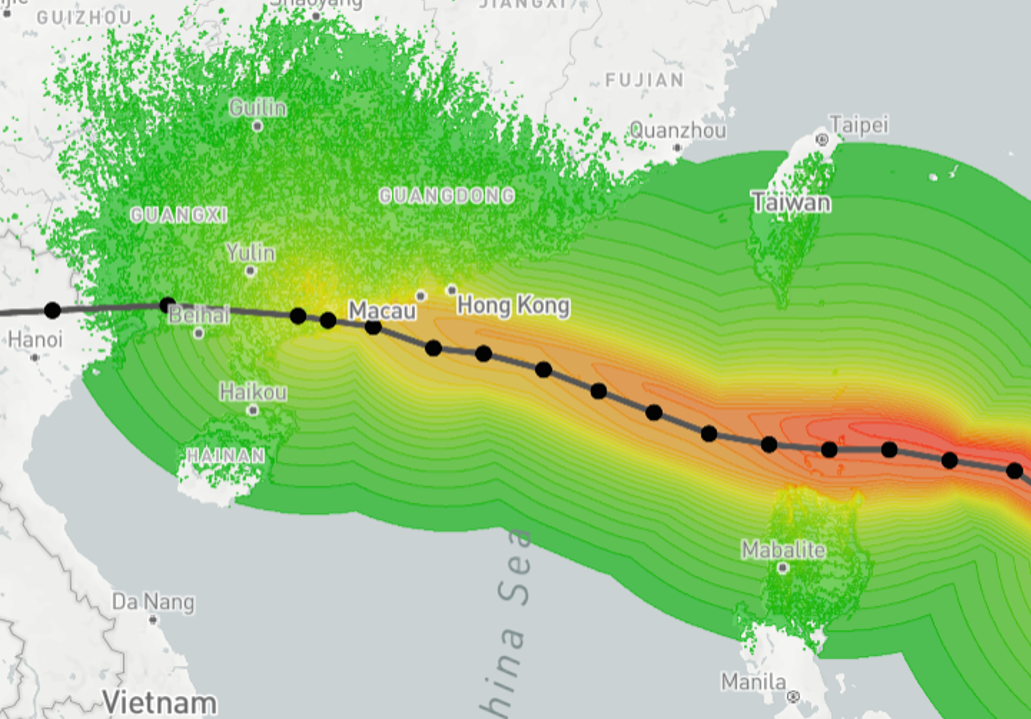
Updated: September 26, 2025

Super Typhoon Ragasa is so far the world’s most powerful storm this year, reaching status as an equivalent category-5 on the Saffir-Simpson Scale, with maximum sustained winds of roughly 165 mph (265 km/hr).
Despite its high intesity, overall damages reported so far are not as high as initially feared.
Live Report: Super Typhoon Ragasa Landfall Status
Philippines
- Typhoon Ragasa (named Super Typhoon Nando in Philippines) severely impacted the northern areas of the Philippines, where the storm made landfall at peak intensity on the Panuitan Island in Cagayan province. Peak wind gusts reached 230 km/h (143 mph).
- Authorities ordered widespread evacuations at time of publication, and at least 11 deaths have been reported.
- The typhoon exacerbated the existing monsoon, resulting in flooding and landslides that have damaged properties as well as bridges and roads.
- Damage to crops and livestock has also been reported, with initial losses estimated to be at least PHP 565 million (USD 10 million).
Mainland China
- Ragasa made landfall in the southern province of Guangdong of Mainland China on Wednesday around 17:00 local time (10:00 UTC) near Yangjiang City.
- Just prior to landfall at 06:00 UTC September 24, the Typhoon had 1-minute sustained winds of roughly 193 km/h (120 mph), equivalent to a category-3 on the Saffir-Simpson Scale according to the Joint Typhoon Warning Center (JTWC). Minimum central pressure was reported at 950 mb per the Japan Meteorological Agency.
- Millions of people were evacuated from southern cities of Mainland China in preparation, while some local insurers provided pre-warning to their policyholders and provided guidance on prevention measures.
- Restrictions were quickly lifted as the storm passed, and Xinhua news agency reports that Chinese authorities have allocated around USD 50 million for rescue and recovery efforts. At the time of publication, no deaths have been reported in Mainland China.
- The storm quickly weakened after making landfall, although it still caused flooding and wind damage to trees and light structures. Economic losses are expected to be less than they were for Typhoon Mangkhut in 2018 (CNY 14.2 billion/USD 2 billion).
Hong Kong and Macau
- Typhoon Ragasa tracked as close as 120 km southwest of Hong Kong on 24 September, with 22 flood cases and 101 people injured.
- The city experienced hurricane winds similar to Typhoons Hato in 2017 (HKD 900 million/USD 116 million) and Wipha 2025 (expected to be less than HKD 360 million/USD 46 million), but weaker than Manghkut 2018 (HKD 3 billion/ USD 380 million).
- Wind speeds between 70 and 96 km/h were reported across Victoria Harbour, with maximum wind gust of 148 km/h in North Point. Ragasa also brought a total of 100 to 200 mm rainfall to Hong Kong. Maximum sea level rise of 3.4 m in the morning was below the levels of Typhoon Hato (3.57 m) and Mangkhut (3.88 m).
- Coastal locations were impacted most by rough seas and high waves, which caused damage to some waterfront properties. Precautions by the local government in response to previous typhoons helped to reduce the damage.
- In Macau, low-lying areas were flooded with water levels high as 1.5m. More than 3,000 people were evacuated and 7 people were injured.
Taiwan
- At the time of publication, at least 14 fatalities have been reported after severe flooding in the east, following the burst of a barrier lake in Hualien County on Tuesday. At least 11 remain missing as of reporting on 26th September. Ragasa passed south of Taiwan but still brought strong winds and excessive rainfall, with flood impacts in mountainous areas.
- At present only limited preliminary loss estimates have been released. The Ministry of Agriculture estimates that agricultural damages to be NTD 257 million (USD 8 million).
Vietnam and Laos
- The remnants of Ragasa brought heavy rainfall with flooding to portions of Vietnam and Laos. The Vietnamese authorities issued flood warnings before the storm entered the country, but so far there have been no reports of major damage.
